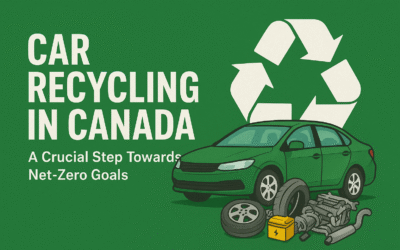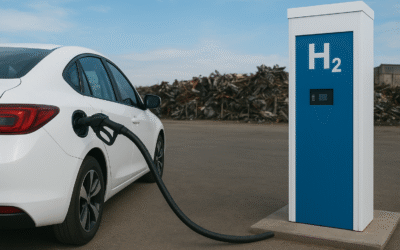Introduction
The automotive industry now faces a time when every decision we make about our vehicles matters for the planet. While many people recognize that electric cars can lower emissions, far fewer understand the significant role used car parts play in this effort.
Choosing reused auto parts does more than save money or keep a car running longer. It directly reduces carbon emissions, conserves natural resources, and cuts down on industrial waste. Let us explore how this simple choice can make a meaningful difference to our environmental footprint.
Why Car Manufacturing Creates High Carbon Emissions?
Building a new car sets off a long and energy-intensive production process. It begins with extracting raw materials such as steel, aluminum, copper, and plastics. These materials then go through processing, transportation, and assembly. Each step consumes substantial fuel and electricity. Research indicates that manufacturing one average passenger vehicle produces between 6 and 35 tons of CO₂. The exact amount depends on the model and materials involved.
Each new engine, transmission, or alternator produced further increases this carbon footprint. In fact, making steel and aluminum alone accounts for nearly 8% of global carbon emissions. When we reuse a car part, we avoid the need to manufacture a new one. This saves the energy and emissions linked to mining and metal production.
How Reusing Auto Parts Lowers Carbon Emissions?
When a car is retired, many of its components are still functional or can be repaired. Auto recyclers inspect these parts, clean them, and offer them for resale. This cycle prevents unnecessary new manufacturing and reduces waste. Here is how it helps.
-
- It reduces the energy required for production, since refurbishing used parts consumes far less electricity and heat than making new ones. Refurbishing or reusing parts requires far less energy.
- It lowers industrial waste. Fewer new parts mean less metal scrap and industrial byproducts from factories.
- It decreases what ends up in landfills. Reusing parts keeps tons of material out of landfills, where metals can contaminate soil.
- It avoids emissions from transporting materials. Moving raw materials from mines or overseas factories uses a lot of energy. Reused parts eliminate that need.
The Environmental Role of Auto Recycling Yards
Today’s auto recycling yards operate with strong environmental standards. They are not simply junkyards. When a car arrives at a licensed facility, it is carefully depolluted. All fluids such as fuel, oil, and coolant, are safely drained and disposed of.
After that, usable parts are removed, tested, and sorted. Valuable metals like steel, aluminum, and copper are recycled into new raw materials. This process reduces pollution and allows resources to reenter the manufacturing cycle.
Auto recycling also helps prevent illegal dumping, which was once a major source of soil and air contamination. In places like Ontario and across North America, regulated recyclers keep millions of tons of metal out of landfills each year.
Energy Savings from Recycled Metals
The energy savings from metal recycling are impressive. Producing recycled aluminum uses 95% less energy than making new aluminum from ore. Recycled steel saves about 60 to 70 percent of the energy needed for virgin steel production.
Consider how much metal goes into a single car. An average sedan contains roughly 900 kilograms of steel and 150 kilograms of aluminum. Recovering and reusing these materials through part recycling leads to major energy savings.
Used Car Parts and the Circular Economy
Moving toward a circular economy is a key global strategy in the fight against climate change. In this system, products and materials are kept in use for as long as possible. The used auto parts industry is a perfect example of this idea in practice.
Rather than discarding vehicles and buying new parts, a circular economy promotes repair, reuse, and remanufacturing. This keeps the carbon embedded in existing materials from being released through new production.
For both automakers and consumers, this system cuts costs and emissions. It creates a loop where fewer new resources are extracted and more value is gained from materials already in use.
Also Read: Scrap Metal Recycling in Canada: Driving Sustainability and a Circular Economy
The Important Role of Consumers
The carbon reduction benefits of reusing car parts rely heavily on consumer decisions. Each time a car owner chooses a used or refurbished part over a new one, it influences the entire supply chain.
Here is how individuals contribute to this positive impact.
-
- Demand for reused parts encourages recyclers to expand and recover more vehicles.
- Lower production demand reduces industrial energy use and overall emissions.
- Fewer scrapped materials mean less waste and lower landfill emissions.
Challenges in Promoting Used Auto Parts
Even with clear environmental advantages, some people still hesitate to buy used parts. Concerns about quality, warranty coverage, and compatibility often hold them back. Some repair shops also prefer new parts for easier sourcing and higher profits.
Fortunately, this perception is changing as certified recyclers and online platforms make it easier than ever to find reliable used components. In markets like Canada and Europe, strong regulations for part inspection and labeling have increased public trust.
Government policies that support circular economy practices could further boost the use of reused parts. Incentives for certified recyclers or carbon credit systems for sustainable choices would strengthen the industry.
How Businesses Benefit from Supporting Used Parts?
Repair shops, insurance companies, and fleet owners can all benefit from using recycled parts. Besides lower costs, it helps them meet sustainability targets and build a greener reputation.
Many automakers now also take back old vehicles and recycle parts for resale. This turns environmental responsibility into a business opportunity. As global emission standards become stricter, this approach helps companies prepare for future carbon regulations.
Also Read: Importance of Responsible Scrap Car Removal: Environmental Benefits
Final Thoughts
Reusing car parts is more than a way to save money. It is a quiet but powerful movement against carbon emissions. Every used engine, transmission, or body panel that is reused means less mining, less energy waste, and fewer greenhouse gases released. The impact grows with each part we choose to reuse.
For drivers, repair shops, and recyclers, supporting the used car parts industry is one of the most practical ways to combat climate change. By selecting reused components and working with certified recyclers, we help create a cleaner and more sustainable automotive future.





